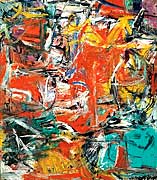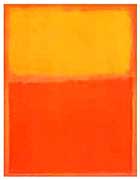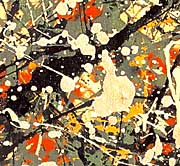|
Mark Vallen's
Newsletter. Nov. 2003 |
Art Activism
& Social Change |
www.art-for-a-change.com
|
|
A R T F O R
A C H A N G E | |
|
|
|
1) - BEHIND THE CURTAIN...
Sixty Years of Russian Impressionism and Soviet Realism
2) - FREE ENTERPRISE PAINTING... How the CIA supported the Abstract
Expressionist movement
___________________________________________
|
Soicher
Marin Gallery in Hawthorne California has mounted
a remarkable exhibition they call
Behind the Curtain - Sixty Years of Russian Impressionism
and Soviet Realism. Approximately 60 paintings
from the former Soviet Union comprise the show, covering
a period from the 1930's to the 1970's. The genre is known
as Soviet Socialist Realism,
where common workers and peasants laboring for the socialist
future are extolled and glorified. The theme notwithstanding,
these are simply some of the most beautiful and technically
proficient oil paintings I've seen in a long time. I highly
recommend this exhibition!
|
|
|
The exhibit
runs until January 10th, 2004. Soicher Marin Gallery is
located at 12824 Cerise Ave in the city of Hawthorne. Phone:
310-679 5000 x135. The Gallery also maintains a website
exhibit, at: www.soicher-marin-gallery.com
__________________________________________
|
 |
FREE
ENTERPRISE PAINTING
How the CIA supported the Abstract Expressionists
For
those who still regard art as being "above" politics consider
the following. The Central Intelligence Agency financed,
organized, and assured the success of the American abstract
expressionist movement, using artists like Jackson Pollock,
Sam Francis, Willem de Kooning, Barnett Newman, Robert Motherwell,
and Mark Rothko, as weapons in the struggle against the
Soviet Union.
|
|
Frances Stonor
Saunders has presented this matter of public record in her
well documented book, The Cultural Cold War - The CIA
and the World of Arts and Letters. Saunders informs
us that during the height of the Cold War in the 1950's,
the CIA secretly promoted abstract expressionism as a means
of discrediting the socialist realism of the Soviet Union.
The Agency's scheme was really two fold, to shift the center
of the art world away from Europe and to the United States,
and to create a national art that would extol unfettered
liberty (without challenging the political status quo in
the US of course). The CIA noted a group of little known
upstart American artists and thought them perfect to help
execute the strategy.
The abstract
expressionists were attacking convention with their "action
painting", an avant-garde aesthetic that pronounced the
act of painting to be more important than the results. These
artists were the embodiment of an iconoclastic and fiery
individualism, but their artworks contained a total absence
of recognizable subject matter, not to mention overt politics.
They abandoned the concept of paintings offering narratives
and instead favored a headlong rush into the mystical where
agitated fields of color were the only message. Viewers
could, and did, read virtually
anything into such works.
|
|
Initially the
abstract expressionists were received with scorn and contempt
by reactionary art critics, members of the press, and right
wing politicians. The movement was denounced on the floor
of Congress as a communist conspiracy. Jackson Pollock was
infamous for dripping, pouring, and hurling paint at the
unstretched canvasses he laid out on his studio floor, so
newspapers came to openly mock Pollock as "Jack the Dripper." All the more
surprising then that the CIA was determined to take this
motley group of eccentric bohemians and transform them into
the champions of Americanism.
|
 |
|
|
The spy agency created
and staffed an international institution they named the Congress
for Cultural Freedom (CCF), and from 1950 to 1967 (when the front
group was at last exposed as a CIA operation), the spook endowment
had secretly bankrolled the abstract expressionist movement with
untold millions of dollars. The CCF organized international gallery
and museum exhibits and CCF operatives worked to persuade collectors,
curators, and critics that Pollock, Rothko, Motherwell, et al,
were the peerless artists of the age. The CIA orchestrated the
publication of a major article on Jackson Pollock in LIFE Magazine
declaring him "the shining new phenomenon of American art", and
the "greatest living artist."
|
 |
The CCF brought action
painting to the attention of Nelson Rockefeller, whose family ran
the New York Museum of
Modern Art (MoMA). Rockefeller
was so enamored with what he saw that he actually referred to
abstract expressionism as "free enterprise painting." Not surprisingly
Rockefeller began his own action painting collection, furthering
the largesse and esteem of the abstract expressionist movement.
It's hard to imagine that the artists didn't know where their
money and support was coming from, but as Saunders put it in her
book, "if they didn't they were... cultivatedly and culpably,
ignorant."
|
|
Even
after Pollock's death in 1956 the Agency continued to promote
his works by organizing posthumous exhibitions. The covert agenda
suffered an unmasking in 1967 when Ramparts Magazine published
revelations about the entire affair. President Johnson eventually
ruled out domestic CIA programs and after '67 the CCF was reorganized
into the International Association for Cultural Freedom, which
extended operations for another decade.
|
|
The spy agency's
stratagem had collapsed but an unalterable course of events had
been set into motion. As is the rule with covert operations there
were unforeseen consequences, or what critics call "blow back."
While the proposed target of the CIA was the communist ideal of
art, it is not an exaggeration to say that unintended blow back
included the undermining of figurative realism.
|
 |
|
The
CIA applied considerable muscle in it's endeavor to support and
advance the abstract expressionist movement, and in large part
they were successful. Realism became passé as art critics
focused on singing the praises of action painting. Galleries,
museums, and private collectors spent appreciable fortunes on
collecting abstract expressionist works while realist painters
languished in obscurity. It is a travesty the art world has not
fully recovered from - or acknowledged, and to this day elite
opinion favors nonrepresentational over realistic artworks. __________________________________________
|
Mark Vallen's ART FOR
A CHANGE website serves as a resource center for Art Activism.
It encourages and promotes the creation of artworks that envision
a just, peaceful world. Please inform others of this site, and
forward this notice to all appropriate lists and individuals.
If you wish to be added or removed from the AFC mailing list,
or if you'd rather receive a text only version of this mailing...
send an e-mail request.
|
|
"I believe that in a society
every man has the right to live, and to live well in proportion
to his work. Since an artist cannot live... it follows that society
is
criminal and badly organized." ~ Paul Gauguin.
|
www.art-for-a-change.com
|